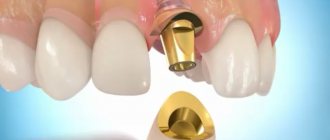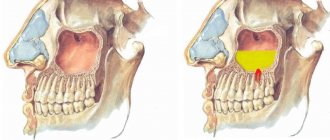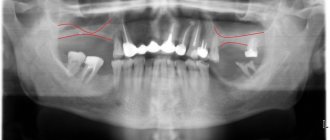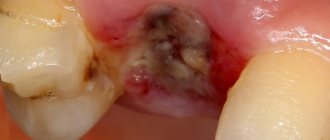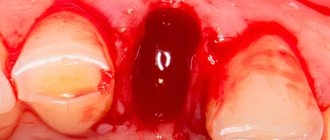After tooth extraction, patients closely monitor the healing process of the hole. And usually everything goes well - the wound heals, new tissues form, redness in the area of the injured gum disappears. But sometimes frightening formations appear - lumps, hematomas, compactions. Of particular concern is the white growth after tooth extraction. In this case, consulting a doctor is advisable, since the growths can be both safe and requiring treatment.
Signs of alveolitis
The following symptoms indicate alveolitis of the socket:
- Socket pain that continues or renews on the 3-5th day after tooth extraction. In an uncomplicated postoperative period, it resolves in 1-2 days. At the beginning of the disease it is aching and becomes more intense after eating. At a later stage, the pain is constant and cannot be tolerated; painkillers help for a short time. It can radiate into the ear, into the temple on the side of the sore hole.
- The appearance of a bitter taste and putrid odor from the mouth.
- Enlargement and tenderness of the submandibular lymph nodes.
Upon examination, when alveolitis has just begun, the dentist discovers:
- redness of the gums,
- contents in the form of remains of a loose blood clot, food particles, saliva in the wound,
- that the hole is “dry”;
- in the midst of inflammation:
- swollen red mucous membrane along the edges of the hole,
- soreness when touched,
- there is a gray or yellowish coating on the walls.
Content:
- When white plaque is the norm
- When white plaque is a harbinger of disease
- Why do complications occur after tooth extraction?
- How to recognize the problem
- Diagnostic measures
- Treatment of alveolitis
After tooth extraction, it is important to monitor the condition of the mucous membrane.
Very often a white coating appears in the extraction area. It frightens patients because it seems something strange to them, and to some it resembles an accumulation of purulent masses. It should be noted that white plaque in the socket after tooth extraction can be either normal or a complication. In the first case we are talking about natural regeneration, in the second - about alveolitis.
Causes of alveolitis
Normally, after a tooth is removed, a clot of blood cells and fibrin, the protein from which a blood clot is built, forms in the socket. It almost completely covers the bottom and walls of the alveoli. The clot serves as a mechanical barrier, biological protection against infection and additional injury to the wound surface. In this case, healing occurs by primary intention. The wound is slowly filled first with loose tissue, then with denser connective tissue, and later with young bone.
But there are situations when the healing process is disrupted.
Inflammation of the socket occurs if:
- The operation was highly traumatic, which reduced the protective capabilities of one’s own tissues;
- The blood clot, as the main defense, is broken or completely absent (“dry socket”):
- prolonged bleeding;
- early destruction of the clot;
- non-compliance with the rules of care (for example, increased rinsing, eating hard or too hot food soon after surgery);
- Tooth extraction was carried out for emergency reasons due to an acute infectious process: periodontitis or periodontitis with complications;
- There are common reasons:
- reduced immunity;
- blood clotting disorder;
- elderly age;
- lack of proper dental hygiene.
Treatment of alveolitis
If alveolitis occurs after tooth extraction, you need to undergo dental treatment aimed at:
- elimination of the infectious focus;
- preventing possible complications;
- maintaining the integrity of the rest of the dentition.
First, the dentist cleans the socket and rinses it. It is important to wash away all purulent masses and dead tissue from it. Antiseptics and hydrogen peroxide work well for this purpose.
To reduce painful symptoms, which deprive the patient of the opportunity to fully rest and work, analgesics are used. It is better to use them by applying applications. Compresses are changed every half hour. It is also possible to take drugs orally, that is, in the form of painkillers and anti-inflammatory tablets.
If the patient has concomitant diseases or reduced immunity, the doctor may decide to prescribe antibiotics. They quickly relieve inflammation and speed up the healing of damaged tissue.
If you seek qualified dental care in a timely manner, the prognosis for alveolitis is favorable. After 3-5 days, the symptoms begin to subside, and the person’s well-being improves. Residual socket pain may persist for another 2-3 weeks, but it does not pose a threat.
Diagnosis and treatment of alveolitis of the socket after tooth extraction
If you have had a tooth removed, but after 2 days the pain in the socket has not gone away, or additional signs of inflammation have appeared, you should not postpone your visit to the doctor. Self-medication can lead to complications such as periostitis, osteomyelitis, and damage to adjacent teeth. The sooner treatment begins, the faster and with less risk of unpleasant consequences the wound will heal.
Even if your tooth was removed in another clinic, our specialists will help you.
Typically, diagnosing alveolitis of the tooth socket is not difficult. A medical history and examination is sufficient. But if necessary, to clarify the depth of the lesion, you may be prescribed additional studies: radiography or radiovisiography.
SM-Dentistry uses only high-quality materials; all instruments are sterilized using powerful sterilizers that eliminate the possibility of infection.
Treatment measures for alveolitis at SM-Dentistry:
- Local anesthesia will relieve acute pain and help you endure treatment.
- Complete cleansing of the wound from parts of the destroyed blood clot, food debris, plaque - a clean wound surface should remain.
- Treatment with disinfectants, antimicrobial and anesthetic agents.
- Application of a special turunda (tampon with medications).
The doctor will give recommendations for further care:
- special baths with antiseptic;
- painkillers;
- gentle diet.
It is possible that treatment of socket alveolitis will need to be supplemented with physiotherapeutic methods.
Why do complications occur after tooth extraction?
The most common reason for the development of complications is the patient’s failure to comply with medical prescriptions. Normally, the hole should heal within a few days. She shouldn't be sick for a long time. As a result of the fact that the blood clot closes it, it is reliably protected from viruses and food debris.
It happens that a person actively rinses the wound or constantly touches it with his tongue, fingers, and tries to remove the light coating. Then the clot displaces or does not form completely, the tissue becomes infected and alveolitis develops.
Untreated neighboring teeth can also lead to disease (which is why all carious “cavities” need to be treated before removal), and failure to comply with the rules of oral hygiene. If you properly prepare for extraction and follow all the doctor’s instructions, the risk of developing alveolitis after removal will be minimal.
Prevention of alveolitis at SM-Dentistry
If the operation is not an emergency, then dentists first treat caries and other inflammatory diseases in the oral cavity, which can become a source of infection.
After the operation, you will receive detailed recommendations for caring for the socket so that the blood clot forms correctly and does not break down prematurely. To do this, you must follow a diet (do not eat hard or hot foods), do not use intensive rinsing and cleaning in the area of the injured hole, and use antiseptic and painkillers.
Sign up for a consultation with a dental surgeon by calling 24/7 in Moscow +7 (495) 777-48-06.
Dentist consultation Treatment of caries
Edema
Swelling is another unpleasant consequence of tooth extraction. As a rule, it appears the next day after surgery and reaches its maximum value on the third day, after which it begins to decrease.
Cold compresses can be used to reduce swelling. To do this, you need to prepare ice cubes in advance, wrap them in cloth and apply them to the operation site for no more than twenty minutes. After a twenty-minute break, the procedure can be repeated. But it should be remembered that this method is effective in combating edema only in the first thirty-six hours after surgery.
Prices
| Name of service | Price, rub.) * |
| Initial consultation with a dentist-therapist | 1,500 rub. |
| Repeated consultation with a dentist-therapist | 800 rub. |
| Treatment of caries (imaging, anesthesia, isolation of the oral cavity, installation of an insulating lining and filling made of composite light-curing imported material) | from 4,350 rub. |
| Treatment of alveolitis with socket revision | 3,000 rub. |
We accept VISA, MASTERCARD, MAESTRO bank cards for payment.
Would you like us to call you back?
Temperature increase
Tooth extraction usually does not cause an increase in temperature; in rare cases, there is an increase in temperature up to 37.5º in the first few hours after the operation, but this also goes away by the evening of the same day. If the temperature is higher and lasts longer, this may be a sign of an inflammatory process in the socket. In this case, you should immediately consult a doctor.
Why bone material may “come out” after surgery
Sinus lifting is an operation to increase bone tissue when there is a lack of it in the area of the maxillary sinuses. It is carried out with the aim of creating a solid foundation for reliable fixation of the dental implant. The basis of this foundation is bone material, which is produced in the form of granules. It is inserted into the artificially created space between the lining of the maxillary sinus and the periosteal layer of the jaw (for this, the sinus lining is lifted).
In the first 10-14 days, the material is still plastic and capable of deformation and exposure. It is very rare, but it still happens that after surgery, bone chips appear in the oral cavity, exit through the nasal passage or from the nasopharynx. This indicates a violation of the surgical protocol or non-compliance by the patient with the rules of the postoperative period.
Treatment and prevention of alveolitis
Treatment of alveolitis is carried out by a dentist; self-medication is unacceptable. Firstly, you may make a mistake with the diagnosis, as a result all manipulations will be ineffective. Secondly, traditional methods are not enough, and for professional ones you do not have enough experience and equipment.
How is treatment carried out at the clinic? The doctor numbs the wound, cleans it, and puts a tampon with medicine. If foreign bodies (shards of tooth, root, pieces of food) prevent the socket from healing, the dentist removes them. You may need to take antibiotics, undergo physical therapy, baths with medications, and follow a diet during healing (excluding hard, hot foods from the diet). In advanced cases, additional operations are required. Traditional methods are acceptable with the permission of a doctor. For example, rinses with sage, chamomile, burdock and others. These solutions can accelerate tissue healing and alleviate the patient's condition.
What measures exist to prevent inflammation? In the first days, do not eat hard or too hot foods, and do not rinse your mouth. These actions help flush out the clot, which can cause inflammation. If tooth extraction is not an emergency, it is advisable to take care of the treatment of caries and other oral diseases in advance. Give up bad habits during healing: alcohol thins the blood, which prevents the formation of a clot, tobacco increases the risk of infection of the hole. If your gums hurt on the first day after tooth extraction, you can simply take a painkiller.
Two days after tooth extraction, the pain has not subsided, it has intensified, and its character has changed, which means that you should definitely consult a doctor! Alveolitis does not go away on its own; it can only lead to unpleasant consequences and complicate further treatment. Monitor the condition of your teeth especially carefully if there were other diseases of the oral cavity or the body as a whole at the time of removal. Doctors at Comfort Dentistry give recommendations for further care after tooth extraction. They tell you how to treat gums after tooth extraction, and in what cases to contact a dentist. If you doubt the correctness of self-diagnosis, you can call us and consult with a specialist.
What to do if bone loss occurs
If bone material comes out after a sinus lift, this should serve as an incentive for prompt action.
- The sooner the diagnosis is made and adequate treatment is started, the more favorable the further prognosis will be.
- If the start of treatment is delayed, pathological adhesions may develop with the implant being fixed in the wrong position.
In any case, a computed tomography scan is performed first . Allows you to determine the degree of “disaster” and not miss the onset of the inflammatory process:
- assess the condition of bone tissue;
- determine the quantity and placement of the remaining material;
- identify its presence or absence in the maxillary sinus.
If bone chips were released only from the oral cavity
Surgery is being performed. Sometimes it is possible to limit oneself only to plastic surgery of the bone material, filling the resulting gaps and re-applying sutures.
If osteomaterial gets into the sinus
Treatment can last for several months and will take place in several stages:
- Removal of a dislocated implant (if installed).
- Elimination of infectious complications - sinusitis, fistula (if present).
- After 1-2 months, in the absence of repeated complications and normal healing, a repeat sinus lift may be performed.
- Implantation is performed 3-6 months after the new bone is formed.
Our Center specializes in solving problems associated with complications in the maxillary sinuses
Patients often come to us after a failed sinus lift. The Center has a full-fledged ENT department to provide surgical care in complex clinical situations. A modern ENT unit includes all the necessary equipment for carrying out operations, including the removal of foreign bodies that provoked inflammation.
Levin Dmitry Valerievich
Founder and Chief Doctor of the Center

